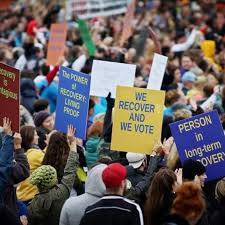 Over the past half-century, the meaning ofthe "recovery community" has undergone considerable changes. First used as an umbrella term to embrace local members of AA, the term was gradually extended to embrace members of Al-Anon and Alateen, members of other Twelve-Step fellowships, and then professional and lay allies of AA and related groups. The term was further stretched through the rise and dispersion of secular and religious alternatives to AA and the phenomenon ofdual citizenship in recovery--individuals concurrently participating in Twelve Step and alternative recovery mutual aid groups.
Over the past half-century, the meaning ofthe "recovery community" has undergone considerable changes. First used as an umbrella term to embrace local members of AA, the term was gradually extended to embrace members of Al-Anon and Alateen, members of other Twelve-Step fellowships, and then professional and lay allies of AA and related groups. The term was further stretched through the rise and dispersion of secular and religious alternatives to AA and the phenomenon ofdual citizenship in recovery--individuals concurrently participating in Twelve Step and alternative recovery mutual aid groups.
Growing public and professional recognition that many people achieved recovery from substance use disorders without formal treatment or recovery mutual aid affiliation spurred some in "natural recovery" to claim membership within an expanding concept ofrecovery community. Individuals in recovery from what were christened "process addictions"--codependency, gambling, eating disorders, sexual addictions, etc.--also claimed territory within the boundaries of the "recovery community." A new addiction recovery advocacy movement spawned new recovery support institutions distinct from mutual-aid fellowships and addiction treatment organizations. Harm reduction projects advocating the legitimacy of non-abstinent pathways of addiction recovery further challenged the conceptual boundaries of recovery and recovery community.
A recently published article by Parkman and Lloyd will be of interest to observers of this recovery community building process. According to Parkman and Lloyd, the internet has extended the traditional definition of community that centered on people sharing living space within a defined geographical area. Instead, "imagined recovery communities" now exist whose members reside worlds apart and never meet face-to-face, and "portable recovery communities" afford people from disparate locations who share common experiences and identities opportunities to periodically gather and then disperse. Parkman and Lloyd further note the variability and fluidity with which people in recovery identify or do not identity with this imagined community. The authors conclude: "For those isolated in their addiction, with very little access to social support, access to an imagined recovery community that can provide support could be a valuable beginning to their recovery efforts."
In reflecting on this evolving recovery community, four overlapping trends are of potential historical import: 1) the growth of an ecumenical "culture of recovery" that respects and blends secular, spiritual, and religious pathways of recovery and transcends geographic, political, economic, religious, racial, and generational barriers, 2) the rise of a new recovery advocacy movement proclaiming there are many pathways to recovery and ALL are cause for celebration, 3) the emergence of new recovery support structures within the arenas of business, law, communications, medicine, religion, education, housing, sports, leisure, and the arts, and 4) the increased linkage of the addiction/recovery experience to other forms of human suffering and healing. Addiction and recovery may become catalytic metaphors aiding broader patterns of personal and cultural transformation, and the broadened experience of recovery community may serve as an incubation chamber for such transformations.
As we witness the progressive splintering of the world's social fabric into closed ideological camps, the community building rising out of the shared experience of addiction recovery is worthy of broader emulation. The wounded healers within this expanding "recovery community" have much to teach the larger cultures in which they are nested. A day may come when we all embrace our shared woundedness, all see ourselves and our communities in a process of recovery, and all join in transforming the world into a healing sanctuary.